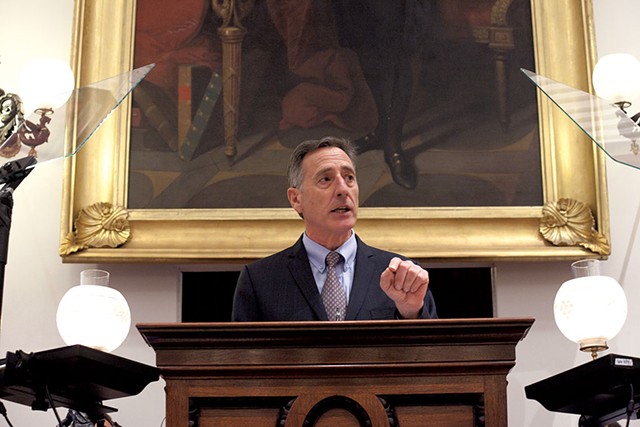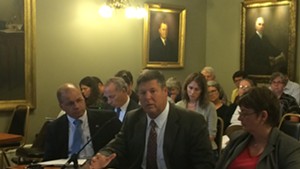
- Matthew Thorsen
- Gov. Peter Shumlin
Five years ago, Gov. Peter Shumlin was confident he had the cure for what ails Vermont's health care system: a government-financed program commonly referred to as single-payer. At the celebratory signing of a law to put the state on that path, Shumlin promised it would be a sustainable and more efficient approach.
But in December 2014, Shumlin abruptly changed course, saying single-payer was too expensive. He called the decision "the biggest disappointment of my political life, so far."
The substitute? Shumlin has settled on something dubbed the "all-payer" model to transform health care in Vermont. The governor's health reform team and the chairman of the Green Mountain Care Board have spent the past year in talks with federal health care regulators about an agreement that would allow the state to make it happen.
"For Vermonters, our innovation will mean not only a health care system that is more affordable, but one that better meets their needs," Shumlin asserted two weeks ago, when he pulled back the curtain on key components of this new initiative.
How would the latest elixir for the state's costly health care system go down?
Seven Days is asking — and answering — the big questions.
So what is an all-payer model?
In simplest terms, it's a new payment scheme for Medicare, Medicaid and private insurers — the entities that pay medical claims on our behalf. Instead of reimbursing doctors and hospitals for each test, procedure and visit — known as a fee-for-service model — payers would contract with doctors and hospitals to provide comprehensive care to large groups of patients for a predetermined amount. That's intended to create financial incentives for doctors and hospitals to keep patients as healthy as possible.
Why is the Shumlin administration doing this?
Health care costs have doubled in the past decade, gobbling up bigger and bigger chunks of the state's budget, Vermonters' incomes and corporate profits. Shumlin made the case for change in his 2016 budget address, calling the rising costs "public enemy No. 1."
"Under the fee-for-service system we have now, we spend more on health care than anyone else in the world, and our outcomes are not as good," Shumlin said. "We have higher infant mortality, higher obesity, and we don't live as long as the countries that are spending less than us. We must do better."
Is Vermont going out on a limb here?
Yes and no. Vermont's all-payer experiment could be the biggest test to date of this concept, but the state is far from alone in looking to move away from fee-for-service medical care. The federal Centers for Medicare and Medicaid Services has funded projects — some in Vermont — to test alternative payment methods, and it intends to switch 80 percent of its services away from the fee-for-service model by 2018.
Obamacare, which Congress enacted in 2010, authorized groups of health care providers to form "accountable care organizations" that would begin to change providers' financial incentives from volume to value.
ACOs are made up of doctors, hospitals and clinics. Three of them formed in Vermont between 2012 and 2014. The University of Vermont Medical Center and Dartmouth-Hitchcock founded the biggest, OneCare, which includes eight other hospitals, physician practices and dozens of other health care organizations, such as nursing homes. Another is made up of community clinics that receive federal funding and four community hospitals. And the third, Healthfirst, is a clutch of physicians unaffiliated with hospitals.
All three ACOs committed to slow the growing cost of caring for Medicare and commercially insured patients.
Who would be in the driver's seat of this all-payer model?
The Green Mountain Care Board, a quasi-independent regulatory panel, would supervise the system. It would set standards for the payment changes, consumer protections and quality metrics. As part of its review of hospital budgets and commercial insurance rates, it would ensure that the hospitals and insurers reflect and carry out the all-payer model.
The payers — Medicare, Medicaid and private insurers — would likely contract with accountable care organizations to help them implement the new payment method. Vermont's three ACOs are discussing merging, but the success of an all-payer model isn't contingent on having a single statewide ACO, officials say.
The ACOs' mission is to improve integration of care, develop data on population health and share best practices — as tools to curb spending and improve health care. Under an all-payer model, the ACOs would assume financial risks for failing to meet cost-reduction targets, but would share in the savings if they succeed. They would have to maintain — even improve — the quality of the care delivered, even as they cut costs.
What's the deal the state wants to make?
The Shumlin administration and the Green Mountain Care Board want the Centers for Medicare and Medicaid Services to grant Vermont a waiver allowing Medicare, a federal health program for the elderly, to be part of this alternative medical payment program. State officials already have the authority to require the other big payers, commercial insurers and Medicaid — which covers low-income individuals — to operate under the same rules.
The heart of this five-year deal would be the state's commitment to cap the growth in health care spending at an annual average of 4.3 percent over the term of the agreement. The state actually believes it can hit a lower target — 3.5 percent. The annual rate of growth ran in the double digits in the early 2000s, shrinking in recent years to 4 percent between 2008 and 2013 and 3.7 percent in 2013.
Even as it promises to rein in spending, the state proposes to be held to three health improvement measures: increased access to primary care; reduction in the prevalence of chronic diseases, as well as improved management of those diseases; and progress in addressing the substance abuse epidemic.
In return, the state wants some expanded coverage from Medicare, including for state opiate treatment and expanded home support to keep the elderly out of hospitals.
Should I be excited or scared about this?
Don't worry, the governor assured us in his budget address. Vermonters would still be able to choose their doctors. For those on Medicare, he said, "Your benefits will not change." The deal, in fact, would add Medicare benefits. Patients would no longer have to spend three days in a hospital before Medicare paid for a skilled nursing home stay. Medicare would cover consultations via teleconferencing and a couple of home visits after patients are discharged from hospitals.
However, Vermont Legal Aid warns that all-payer should be backed up with regulations that protect consumers.
In the current system, insurers wear the black hats and doctors go to bat for patients when they disagree with insurers' decisions about whether a costly treatment is a medical necessity, noted Julia Shaw, health care analyst with Legal Aid. But doctors and hospitals might have financial incentives to deny care under the all-payer model, she wrote in a November paper outlining consumer-protection principles that should guide the deal. Patients must have "avenues for filing appeals and grievances," she said.
Who's for it and who's against it?
The governor is gung ho. His longtime critics hate it, just as they despised single-payer.
Darcie Johnston, conservative political consultant and founder of Vermonters for Health Care Freedom, argues that a cap on spending will force hospitals and doctors to limit care. Former Republican senator Wendy Wilton, now the Rutland city treasurer, suggests the administration can't be trusted to manage health care based on its tarnished record operating the technologically challenged Vermont Health Connect, the online insurance marketplace.
Given that the Centers for Medicare and Medicaid Services is pushing payment reform for Medicare, Democratic House Speaker Shap Smith (D-Morristown) said, he appreciates that the state is negotiating a solution tailored to Vermont's needs. Some lawmakers want to take a vote on the all-payer initiative this session, but Smith said he isn't sure there will be a definitive proposal before the legislature adjourns.
Blue Cross Blue Shield of Vermont, the state's largest insurer, supports the all-payer model. But many operational details have yet to be worked out, spokesman Cory Gustafson said.
The Vermont Medical Society, which represents the state's doctors, has expressed conditional support. It's asking for doctors to be able to operate under traditional Medicare if they don't want to belong to an accountable care organization. It wants the deal to remedy Medicaid's low reimbursements, which lag behind other insurance payments. And it objects to any arrangement that lowers Vermont's already low spending per Medicare enrollee. Executive vice president Paul Harrington noted, too, that doctors who already feel overwhelmed by dealing with insurers would face even more onerous documentation, since reporting outcomes would be key.
The Vermont Association of Hospitals and Health Systems has yet to take a position on all-payer.
Is this a done deal?
Not yet. The state submitted its suggested terms for an agreement to the Centers for Medicare and Medicaid Services last month while also seeking public comments. The Green Mountain Care Board is in the midst of a series of public meetings to help it decide whether to endorse the terms. Although board chair Al Gobeille said he had "tremendous input on the terms," it is new to the rest of the board. "I don't know what they think about this," he said.
The board could pull the plug if it determines that an all-payer model wouldn't deliver the desired transformation. Or CMS could come back with a tweak that would jeopardize the deal, Gobeille said. Still to be answered is whether hospitals and doctors are willing to be part of this new all-payer initiative, he said.
If the plan is a go, it will take until summer to write the contract, Gobeille predicted. The target date to begin phasing it in is January 1 — less than a year away.












Comments (2)
Showing 1-2 of 2
Comments are closed.
From 2014-2020, Seven Days allowed readers to comment on all stories posted on our website. While we've appreciated the suggestions and insights, right now Seven Days is prioritizing our core mission — producing high-quality, responsible local journalism — over moderating online debates between readers.
To criticize, correct or praise our reporting, please send us a letter to the editor or send us a tip. We’ll check it out and report the results.
Online comments may return when we have better tech tools for managing them. Thanks for reading.